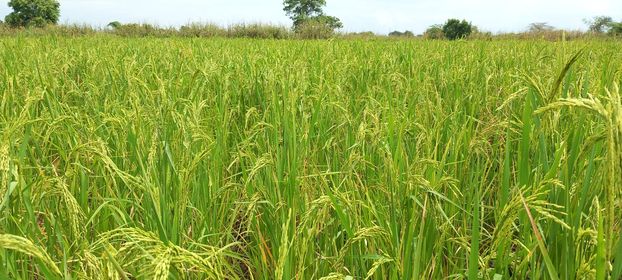You are here: Home | Economy | Humanitarian | News | Number of South Sudanese food insecure to drop in 2024 – IPC

Rice plantation in Twic County. (-)
An Integrated Food Security Phase Classification report has forecast a slight drop in the number of acutely food insecure South Sudanese to 7.1 million people through the 2024 lean season.
This is down from 7.76 million projected to be food insecure through the 2023 lean season.
The report released by the National Ministry of Agriculture alongside the UN’s Food and Agriculture Organization as well as the UN children agency UNICEF, largely attributed the drop to the relative calm in parts of Jonglei, Warrap, and Western Equatorial as well as with investment in infrastructure.
It says the conditions allowed communities to the developed livelihoods, market development and smooth delivery of humanitarian assistance which significantly improved food security in Bor, Tonj South, Tonj North, Tong East, and Tambura.
The lean-season projection from April to July 2024 shows 38 counties and an estimated 98,000 returnees accounting for 75% will be in emergency acute food insecurity.
Returnees fleeing Sudan are facing some of the highest levels of food insecurity.
Despite only accounting for 3 percent of the population, they account for 35 percent of those facing emergency levels of hunger through the lean season.
The most severely food insecure communities are in locations that have been significantly affected by frequent climate shocks, the economic crisis, conflict and insecurity, low agricultural production, reduction in humanitarian assistance, and the effects of the ongoing conflict in Sudan.
In nutrition, the classification also showed an estimated 1.65 million children of about 6 to 59 months who are expected to suffer from acute malnutrition from July 2023 to June 2024.
The total number of Severe Acute Malnutrition and Moderate Acute Malnutrition cases are estimated at 0.48 million and 1.16 million respectively.
According to the classification, Bentiu, the epicentre of the flood crisis in South Sudan, is facing the worst levels and severity of malnutrition with Rubkona county projected to reach IPC Acute Malnutrition Phase 5 by April 2024 for the first time ever.
This is largely the result of the severe flooding.
The nutrition situation is expected to deteriorate through the next lean season with 67 counties projected to be facing serious, critical, or very critical malnutrition levels.
High prevalence of disease, poor access to safe water sources and sanitation, food insecurity, and inadequate feeding practices – compounded by high numbers of children returning from Sudan, are the key contributing factors to the increased acute malnutrition rates.
Only 5 children out of 100 are getting the recommended quality and frequency of food required for optimal growth.
34.6% achieved the Minimum Meal frequency while only 21% achieved the Minimum dietary diversity.
Support Eye Radio, the first independent radio broadcaster of news, information & entertainment in South Sudan.
Make a monthly or a one off contribution.
Copyright 2024. All rights reserved. Eye Radio is a product of Eye Media Limited.